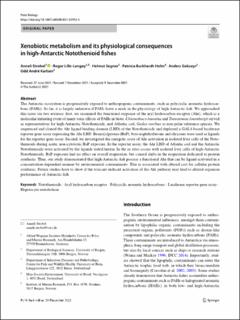| dc.contributor.author | Strobel, Anneli | |
| dc.contributor.author | Lille-Langøy, Roger | |
| dc.contributor.author | Segner, Helmut | |
| dc.contributor.author | Burkhardt-Holm, Patricia | |
| dc.contributor.author | Goksøyr, Anders | |
| dc.contributor.author | Karlsen, Odd André | |
| dc.date.accessioned | 2022-02-07T08:37:05Z | |
| dc.date.available | 2022-02-07T08:37:05Z | |
| dc.date.created | 2022-01-14T17:29:52Z | |
| dc.date.issued | 2022 | |
| dc.identifier.issn | 0722-4060 | |
| dc.identifier.uri | https://hdl.handle.net/11250/2977386 | |
| dc.description.abstract | The Antarctic ecosystem is progressively exposed to anthropogenic contaminants, such as polycyclic aromatic hydrocarbons (PAHs). So far, it is largely unknown if PAHs leave a mark in the physiology of high-Antarctic fish. We approached this issue via two avenues: first, we examined the functional response of the aryl hydrocarbon receptor (Ahr), which is a molecular initiating event of many toxic effects of PAHs in biota. Chionodraco hamatus and Trematomus loennbergii served as representatives for high-Antarctic Notothenioids, and Atlantic cod, Gadus morhua as non-polar reference species. We sequenced and cloned the Ahr ligand binding domain (LBD) of the Notothenioids and deployed a GAL4-based luciferase reporter gene assay expressing the Ahr LBD. Benzo[a]pyrene (BaP), beta-naphthoflavone and chrysene were used as ligands for the reporter gene assay. Second, we investigated the energetic costs of Ahr activation in isolated liver cells of the Notothenioids during acute, non-cytotoxic BaP exposure. In the reporter assay, the Ahr LBD of Atlantic cod and the Antarctic Notothenioids were activated by the ligands tested herein. In the in vitro assays with isolated liver cells of high-Antarctic Notothenioids, BaP exposure had no effect on overall respiration, but caused shifts in the respiration dedicated to protein synthesis. Thus, our study demonstrated that high-Antarctic fish possess a functional Ahr that can be ligand-activated in a concentration-dependent manner by environmental contaminants. This is associated with altered cost for cellular protein synthesis. Future studies have to show if the toxicant-induced activation of the Ahr pathway may lead to altered organism performance of Antarctic fish. | en_US |
| dc.language.iso | eng | en_US |
| dc.publisher | Springer | en_US |
| dc.rights | Navngivelse 4.0 Internasjonal | * |
| dc.rights.uri | http://creativecommons.org/licenses/by/4.0/deed.no | * |
| dc.title | Xenobiotic metabolism and its physiological consequences in high‑Antarctic Notothenioid fishes | en_US |
| dc.type | Journal article | en_US |
| dc.type | Peer reviewed | en_US |
| dc.description.version | publishedVersion | en_US |
| dc.rights.holder | Copyright The Author(s) 2021 | en_US |
| cristin.ispublished | true | |
| cristin.fulltext | original | |
| cristin.qualitycode | 1 | |
| dc.identifier.doi | 10.1007/s00300-021-02992-4 | |
| dc.identifier.cristin | 1981543 | |
| dc.source.journal | Polar Biology | en_US |
| dc.source.pagenumber | 345-358 | en_US |
| dc.relation.project | Norges forskningsråd: 248840 | en_US |
| dc.relation.project | Norges forskningsråd: 244564 | en_US |
| dc.identifier.citation | Polar Biology. 2022, 45, 345-358. | en_US |
| dc.source.volume | 45 | en_US |

